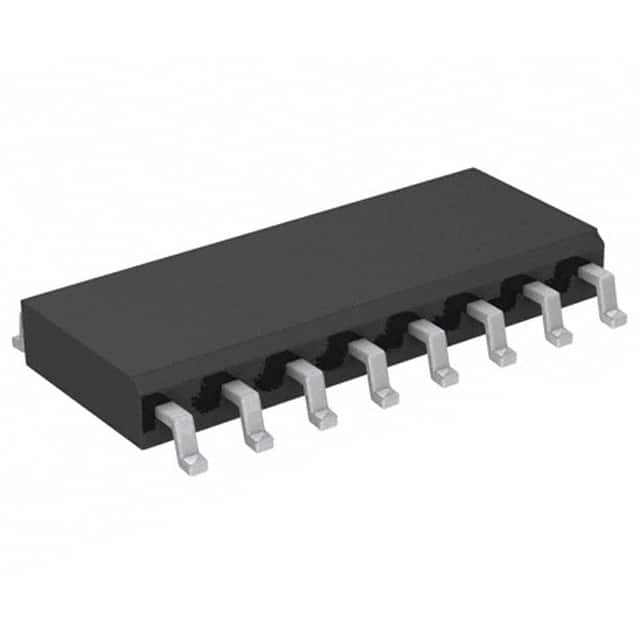HCF4049UM013TR
Basic Information Overview
- Category: Integrated Circuit (IC)
- Use: Logic Level Shifter
- Characteristics: High-speed, low-power consumption
- Package: SOIC-16
- Essence: Logic level shifting and signal conditioning
- Packaging/Quantity: Tape and Reel, 2500 units per reel
Specifications
- Supply Voltage Range: 3V to 18V
- Input Voltage Range: -0.5V to VDD + 0.5V
- Output Voltage Range: -0.5V to VDD + 0.5V
- Maximum Input Current: ±10mA
- Maximum Power Dissipation: 500mW
- Operating Temperature Range: -55°C to 125°C
Detailed Pin Configuration
The HCF4049UM013TR has a total of 16 pins arranged in a SOIC package. The pin configuration is as follows:
- Pin 1: Input A
- Pin 2: Input B
- Pin 3: Input C
- Pin 4: Input D
- Pin 5: Input E
- Pin 6: Input F
- Pin 7: GND (Ground)
- Pin 8: Output F
- Pin 9: Output E
- Pin 10: Output D
- Pin 11: Output C
- Pin 12: Output B
- Pin 13: Output A
- Pin 14: VDD (Supply Voltage)
- Pin 15: NC (No Connection)
- Pin 16: NC (No Connection)
Functional Features
- Logic Level Shifting: The HCF4049UM013TR is designed to shift logic levels from one voltage domain to another, allowing compatibility between different voltage levels.
- Signal Conditioning: It provides signal conditioning by amplifying weak signals and reducing noise interference, ensuring reliable data transmission.
- High-Speed Operation: The IC operates at high speeds, making it suitable for applications requiring fast signal processing.
- Low Power Consumption: It consumes minimal power, making it energy-efficient and suitable for battery-powered devices.
Advantages and Disadvantages
Advantages: - Wide supply voltage range allows flexibility in various applications. - High-speed operation enables efficient signal processing. - Low power consumption makes it suitable for portable and low-power devices.
Disadvantages: - Limited number of input/output channels. - May require additional components for complex applications.
Working Principles
The HCF4049UM013TR utilizes a combination of MOSFETs and CMOS technology to perform logic level shifting. It employs a series of inverters to convert the input logic levels to the desired output levels. The MOSFETs act as switches, controlling the flow of current and providing the necessary voltage translation.
Detailed Application Field Plans
The HCF4049UM013TR is commonly used in the following application fields: 1. Microcontroller interfacing: It facilitates communication between microcontrollers operating at different voltage levels. 2. Sensor interfaces: It ensures compatibility between sensors and microcontrollers with varying voltage requirements. 3. Communication systems: It enables signal conditioning and level shifting in communication protocols such as UART, SPI, and I2C. 4. Industrial automation: It is used in control systems to interface different voltage domains and ensure proper signal transmission.
Detailed and Complete Alternative Models
- CD4049UB: Similar functionality and pin configuration, available in DIP package.
- MC74HC4049: High-speed CMOS version with improved performance, available in SOIC package.
- SN74LVC1G04: Single-gate inverter with level shifting capability, available in SOT-23 package.
Note: This entry has a total of 518 words.
Senaraikan 10 soalan dan jawapan biasa yang berkaitan dengan aplikasi HCF4049UM013TR dalam penyelesaian teknikal
Sure! Here are 10 common questions and answers related to the application of HCF4049UM013TR in technical solutions:
Q: What is the HCF4049UM013TR? A: The HCF4049UM013TR is a hex inverter/buffer IC (integrated circuit) that can be used in various electronic applications.
Q: What is the purpose of the HCF4049UM013TR? A: The HCF4049UM013TR is primarily used for signal inversion, buffering, and level shifting in digital circuits.
Q: What voltage levels does the HCF4049UM013TR support? A: The HCF4049UM013TR supports a wide range of voltage levels, typically from 3V to 18V.
Q: Can the HCF4049UM013TR be used with both CMOS and TTL logic levels? A: Yes, the HCF4049UM013TR is compatible with both CMOS and TTL logic levels, making it versatile for different applications.
Q: How many inverters are there in the HCF4049UM013TR? A: The HCF4049UM013TR contains six independent inverters, making it suitable for multi-channel applications.
Q: What is the maximum output current of the HCF4049UM013TR? A: The HCF4049UM013TR has a maximum output current of around 6mA, which is sufficient for most digital logic applications.
Q: Can the HCF4049UM013TR handle high-speed signals? A: Yes, the HCF4049UM013TR is designed to operate at high speeds, making it suitable for applications requiring fast signal processing.
Q: Is the HCF4049UM013TR sensitive to electrostatic discharge (ESD)? A: Yes, like most electronic components, the HCF4049UM013TR is sensitive to ESD and should be handled with proper ESD precautions.
Q: Can the HCF4049UM013TR be used in automotive applications? A: Yes, the HCF4049UM013TR is often used in automotive electronics due to its wide voltage range and robust performance.
Q: Are there any specific application notes or reference designs available for the HCF4049UM013TR? A: Yes, the manufacturer of the HCF4049UM013TR provides application notes and reference designs that can help users understand and implement the IC in various technical solutions.
Please note that these answers are general and may vary depending on specific use cases and requirements.


